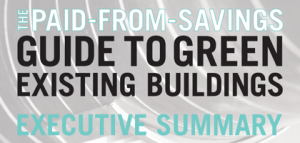 Energy service companies (ESCOs) have provided billions of dollars worth of energy savings through building retrofits — and inspired even the most reluctant clients to seek out energy efficiency. Yet certain building owners can achieve far greater energy and cost savings through the adoption of deep energy retrofits. – Illustration by Lisa Haney
Energy service companies (ESCOs) have provided billions of dollars worth of energy savings through building retrofits — and inspired even the most reluctant clients to seek out energy efficiency. Yet certain building owners can achieve far greater energy and cost savings through the adoption of deep energy retrofits. – Illustration by Lisa Haney
Roy Torbert Rocky Mountain Institute Analyst (Buildings)
ESCOs have often maintained that they would deliver deeper energy savings — if only clients would demand them. Well guess what? The General Services Administration (GSA), the largest owner of commercial real estate in the U.S., is poised to use energy savings performance contracts (ESPCs) for deep savings in selected buildings. These ESPCs require little to no up-front capital from the government, as the energy savings will cover costs of the efficiency improvements. Federal projects typically save 15-25 percent of baseline energy use. GSA, like many other federal clients, is now required to meet dramatic energy savings goals specified by the Energy and Security Act of 2007 and President Obama’s Executive Order 13514. According to GSA Administrator Martha Johnson, “The president challenged government to lead by example in environmental, energy and economic performance. Now GSA is challenging the private sector to partner with us to go above and beyond what has been done before in federal building renovations.”
The new GSA Net Zero Renovation Challenge calls upon the 16 ESCOs pre-qualified for federal buildings to develop innovative, broadly applicable and aggressively energy-saving retrofit plans. Each project will not only aim for deeper savings, but also create a plan to reach net zero energy in the building, to assist GSA in developing long-term solutions for its entire portfolio.
The recently released report from the GSA Net Zero Renovation Challenge Charrette, hosted by Rocky Mountain Institute, details how GSA will work with ESCOs to improve the process of attaining deep savings using 30-35 GSA-owned office buildings. Check out the report to learn how both federal agencies and the major ESCOs will modify their approach to catalyze profitable retrofits with unprecedented savings in federal buildings.
Share this post:

 Despite the general weakness in new construction due to the global recession, one building-related field has continued to grow: retrofits tied to improving the efficiency of facilities. A number of factors have been driving this growth. In the new construction that has been taking place, these same drivers have been influencing the design of the buildings.
Despite the general weakness in new construction due to the global recession, one building-related field has continued to grow: retrofits tied to improving the efficiency of facilities. A number of factors have been driving this growth. In the new construction that has been taking place, these same drivers have been influencing the design of the buildings.